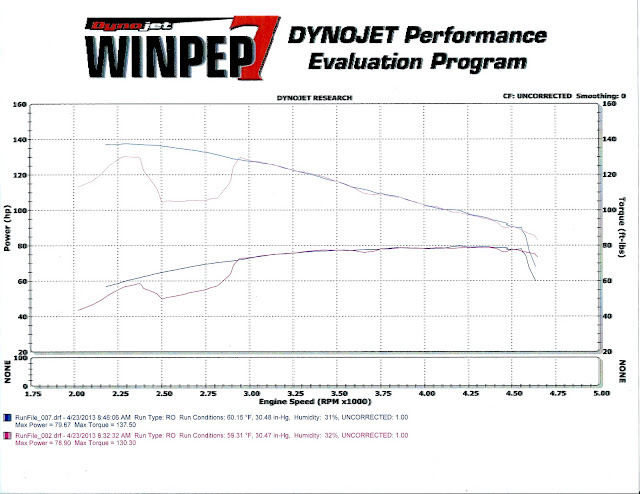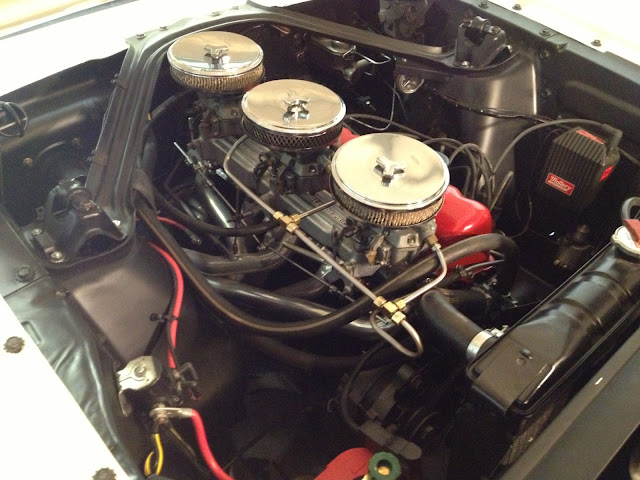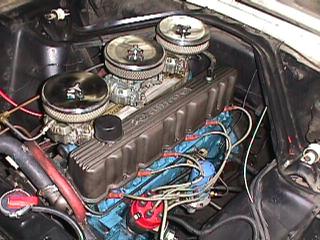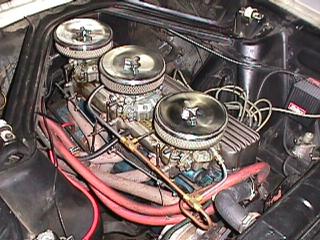I grenaded the camshaft on this engine about ten years ago, rebuilt it shortly thereafter, and finally got the rest of the car reassembled late last summer. The new build has a bit over 1000 miles on it now, runs and feels good, no driveability problems other than a fairly lopey idle.
200ci .030 over, Comp 260H cam, small-chamber 170ci head, Winona bronze valve guides and stellite seats with standard 3-angle, oversize valves (80's vintage spec, need to look up the dimensions, it's been a long time ago), light port+polish, Clifford dual-coil valve springs and tubular pushrods, Mallory Unilite distributor and Promaster coil, 13deg initial + 38deg total advance, Clifford long equal-length headers w/port divider, 1.75" true dual exhaust, Offy 3x1 intake w/Pony Carbs modified Autolite 1100 (spec'd by John Enyeart specifically for this application). Standard trans.
Feels a bit softer than the last time I built it, which was with a 272H Clifford cam and Rhoads lifters, but drives out nicely.
I was absolutely shocked to see the dyno numbers (it's a reliable dyno, reports reproducible numbers on other cars). I thought I'd be anywhere in the 110-130 range, but instead...
Pink is first run, blue is after some tweaks. Dyno operator reported that jetting looked good, engine seemed to run strong, but to my eye something's clearly off. To save your eyes, that's 79.87 hp, 137.5 tq

The dyno operator delayed the opening of the secondaries a bit to smooth out the A/F ratios, again blue is second run...

It's a daily driver, so I'm certainly not after maximum performance, but I sure as heck expected better than this.
Guess it's back to fundamentals, check compression, etc., etc., but hard to imagine how something could be that far out of whack on a fresh engine without introducing driveability issues.

200ci .030 over, Comp 260H cam, small-chamber 170ci head, Winona bronze valve guides and stellite seats with standard 3-angle, oversize valves (80's vintage spec, need to look up the dimensions, it's been a long time ago), light port+polish, Clifford dual-coil valve springs and tubular pushrods, Mallory Unilite distributor and Promaster coil, 13deg initial + 38deg total advance, Clifford long equal-length headers w/port divider, 1.75" true dual exhaust, Offy 3x1 intake w/Pony Carbs modified Autolite 1100 (spec'd by John Enyeart specifically for this application). Standard trans.
Feels a bit softer than the last time I built it, which was with a 272H Clifford cam and Rhoads lifters, but drives out nicely.
I was absolutely shocked to see the dyno numbers (it's a reliable dyno, reports reproducible numbers on other cars). I thought I'd be anywhere in the 110-130 range, but instead...
Pink is first run, blue is after some tweaks. Dyno operator reported that jetting looked good, engine seemed to run strong, but to my eye something's clearly off. To save your eyes, that's 79.87 hp, 137.5 tq

The dyno operator delayed the opening of the secondaries a bit to smooth out the A/F ratios, again blue is second run...

It's a daily driver, so I'm certainly not after maximum performance, but I sure as heck expected better than this.
Guess it's back to fundamentals, check compression, etc., etc., but hard to imagine how something could be that far out of whack on a fresh engine without introducing driveability issues.

 Nice looking Mustang,and engine compartment.
Nice looking Mustang,and engine compartment.
